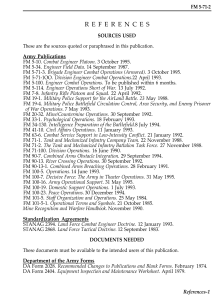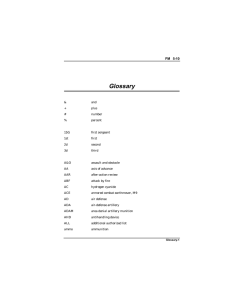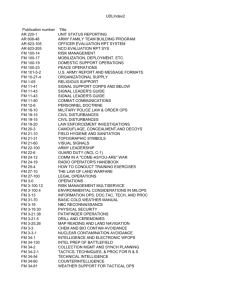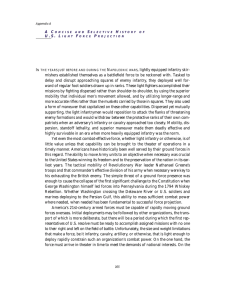THE INTERWAR PERIOD AND WORLD WAR II
advertisement
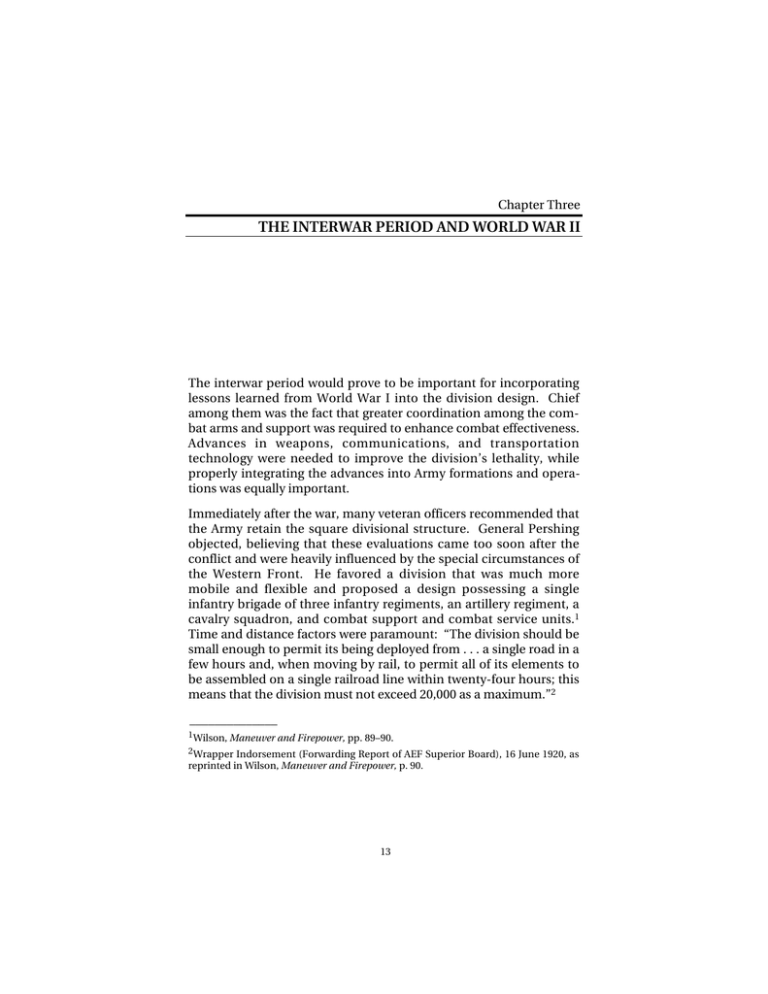
Chapter Three THE INTERWAR PERIOD AND WORLD WAR II The interwar period would prove to be important for incorporating lessons learned from World War I into the division design. Chief among them was the fact that greater coordination among the combat arms and support was required to enhance combat effectiveness. Advances in weapons, communications, and transportation technology were needed to improve the division’s lethality, while properly integrating the advances into Army formations and operations was equally important. Immediately after the war, many veteran officers recommended that the Army retain the square divisional structure. General Pershing objected, believing that these evaluations came too soon after the conflict and were heavily influenced by the special circumstances of the Western Front. He favored a division that was much more mobile and flexible and proposed a design possessing a single infantry brigade of three infantry regiments, an artillery regiment, a cavalry squadron, and combat support and combat service units.1 Time and distance factors were paramount: “The division should be small enough to permit its being deployed from . . . a single road in a few hours and, when moving by rail, to permit all of its elements to be assembled on a single railroad line within twenty-four hours; this means that the division must not exceed 20,000 as a maximum.”2 ______________ 1 Wilson, Maneuver and Firepower, pp. 89–90. 2 Wrapper Indorsement (Forwarding Report of AEF Superior Board), 16 June 1920, as reprinted in Wilson, Maneuver and Firepower, p. 90. 13 14 The U.S. Army Division in the Twentieth Century The debate over the divisional structure was framed by the assumption that North America would be the theater in which it would most likely be deployed. The static battlefield, characteristic of World War I in Western Europe, was viewed as a thing of the past as “technological advances in artillery, machine guns, and aviation made obsolete stabilized and highly organized defensive lines whose flanks rested on impassable obstacles, such as those encountered on the Western Front.” 3 However, despite Pershing’s preference for a much smaller and flexible division of three regiments, two prominent redesign efforts, the Superior Board (1919) and Lassiter Committee (1920), recommended square designs. In answering the call to increase mobility, the division was cut in size by reducing from four to three both the number of platoons in infantry companies and the number of companies in battalions; 155-mm howitzers and some support troops were also eliminated.4 It is interesting to note that the Lassiter Committee wished to retain the brigade-based square division in part because a triangular design would have eliminated the brigade command billets filled by brigadier generals.5 The reduced square division was tentatively approved by Army Chief of Staff General Peyton March in August 1920 at 19,385 men and grew to 19,997 men a year later.6 Pershing, who was to become chief of staff soon after, may have ultimately acceded to a smaller square design because he wished to avoid embarrassment: many of his own officers had recommended the square design while serving on the Superior Board.7 At the same time, following much criticism for the bloated and unwieldy 1917 design, the postwar cavalry division was radically reduced from approximately 18,000 men to 7,463.8 After the square infantry division was reduced, the infantry division was not to be significantly reorganized again until 1939, primarily because of struggles within the Army. Nevertheless, important studies conducted in this period eventually led to the modern, flexible ______________ 3 Wilson, Maneuver and Firepower, p. 91. 4 Wilson, “Mobility Versus Firepower,” p. 50. 5 Wilson, Maneuver and Firepower, p. 91. 6 Ibid., pp. 92, 95. 7 Ibid., p. 94. 8 Ibid., pp. 38, 95. The Interwar Period and World War II 15 combat division. Three needs and a belief greatly influenced change in the division in 1939: the need for increased mobility, greater flexibility, and improved integration of new equipment, weapons, and firepower in motorized and mechanized formations and the belief that North America was to be the battleground of the future (while another war in Europe was deemed unlikely). These factors led to the development of a division design that was flexible and mobile, able to take advantage of new equipment and weapons, while operating on a fast-moving, fluid battlefield that might not necessarily have a well-developed infrastructure.9 Two types of divisions would emerge just prior to the U.S. entry into World War II: the triangular infantry division and the combat command-based armored division. The designs of both underwent extensive modification throughout the war, adapting to battlefield conditions, resource limitations, and the shortcomings of assigned weapons. Historian John Wilson identified three principal factors driving initial design and change during the war: the availability of men, the availability of shipping space, and the availability and quality of equipment. On this last point, the Army continuously was forced to tinker with the division’s design to compensate for inferior weapons, or to accommodate improved ones.10 The Triangular Infantry Division In September 1939, with the onset of war in Europe, new Chief of Staff General George C. Marshall ordered a reorganization of the Army’s infantry divisions into smaller three-regiment “triangular” divisions. Following years of extensive testing conducted under then Army Chief of Staff General Malin Craig, General Marshall approved the new triangular design to put greater maneuverability and flexibility into the divisions, with the additional advantage that the National Guard divisions could easily adopt it.11 Craig initiated the ______________ 9 Major Glen R. Hawkins, United States Army Force Structure and Force Design Ini- tiatives, 1939–1989, Advance Copy, United States Army Center of Military History, Washington, D.C., 1989, pp. 15–16. 10Wilson, Maneuver and Firepower, p. 201. 11Weigley, History of the United States Army, p. 424; Hawkins, p. 15; Wilson, Maneuver and Firepower, p. 133. 16 The U.S. Army Division in the Twentieth Century reorganization effort in 1936, and preliminary triangular designs had reduced division manpower by more than one-third to 13,512.12 Testing was conducted via the Provisional Infantry Division (PID) from 1937 to 1939. The elimination of horses and the adoption of motor vehicles greatly increased the speed and range of these new formations. The brigade echelon was eliminated. As a result, the three regimental combat teams and a field artillery regiment (four battalions: 3 x 105-mm, one to each of the regiments; and 1 x 155mm for general divisional support) could then operate directly under the division commander, providing enhanced responsiveness and flexibility. A cavalry reconnaissance troop equipped with lightly armored vehicles was also assigned to this division, in addition to engineer, signal, quartermaster, military police, medical, and maintenance units. The triangular division enhanced mobility because its smaller size required much less road space than the square division, and it could deploy from the movement formation more quickly. Reporting on the results of the PID study, Brigadier General Lesley McNair proposed significant streamlining in the interest of economy, eliminating some engineers and signal assets, and shifting much of the reconnaissance and support to higher echelons, eventually yielding a division with a wartime authorized strength of 11,485 personnel.13 After the 1940 Louisiana maneuvers, authorized division manpower was bulked up to 15,245 men (see Figure 3.1). This new infantry division had a minimum of organic artillery and support units as a result of extensive pooling at higher echelons; tight shipping constraints also had an influence on limiting the division’s size.14 Planners believed that the division would always be part of a larger force in any engagement, thus permitting a more efficient dis______________ 12Wilson, Maneuver and Firepower, pp. 127–128. 13Ibid., pp. 130–132. 14 Kent Roberts Greenfield, Robert R. Palmer, and Bell I. Wiley, The Army Ground Forces: The Organization of Ground Combat Troops (Washington: Historical Division, Department of the Army, 1947) p. 300; Wilson, Maneuver and Firepower, p. 180. Both Chief of Staff General George Marshall and Lt. General McNair were strong proponents of pooling assets at higher echelons, as a reaction to personnel and equipment shortages and prevailing tight shipping conditions. The Interwar Period and World War II 17 15,245 HQ SVC HHC 12 x 37-mm HHC HHB 105-mm 155-mm & 75-mm HVY WPNS Figure 3.1—The Triangular Infantry Division, November 1940 tribution of resources across corps and armies and rationalizing limits on the division’s organic support. Subsequent changes in this division during World War II were limited to decreasing its size without substantially affecting its structure. Consistent with considerations for economy of force, as well as manpower and shipping limitations, Lieutenant General McNair wanted the division to embody the following qualities: a compact offensive force with a minimum of specifically defensive weapons, streamlined for open warfare, and backed up by units of other types at corps and army level. The infantry division was the fundamental permanent combined arms team, intended to have the right amount of organic artillery and auxiliary elements to enable its infantry riflemen to move forward against average resistance. General McNair hoped to emphasize and clarify this conception by paring away the growth which tended to obscure it. 15 With few exceptions, the triangular infantry division design remained essentially unchanged until 1956. After World War II, the infantry division merely grew in size—to nearly 19,000 men during the ______________ 15Ibid. 18 The U.S. Army Division in the Twentieth Century Korean War—augmenting existing engineer, military police, signal, reconnaissance, intelligence, and other support units.16 The Armored Division First formed in 1940, the World War II–era armored division was a continuously evolving organization noted for its designed flexibility and was a principal forerunner of the modern heavy division. Technological advances in firepower and communications up to that point increased flexibility at lower echelons, particularly after 1942. It was then that the armored division would reap the benefits of an innovative organizational concept in the form of headquarters called Combat Commands, which would build task-organized combat groups for specific missions from the division’s organic units and other nondivisional formations. Although the infantry divisions of World War II also took advantage of task organizing for their tactical employment, the armored combat commands formalized this concept, achieving vertical and horizontal flexibility through the attachment and detachment of combat and combat support units as needed. Spurred by German successes in Poland and France, U.S. armored divisions were initially designed with a heavy emphasis on tanks and scant infantry support. The sheer shock power of German armor, which created dramatic breakthroughs, signaled a new, powerful dimension in warfare that U.S. planners hoped to exploit. Because they were expected to operate independently for extended periods, the new armored divisions were designed with substantial combat and support assets to permit greater flexibility than previous formations had. This original design had an armored brigade consisting of three tank regiments (two light, one medium), an artillery regiment of two battalions, and an armored infantry regiment in support. These nascent armored divisions were lavished with over 14,000 men and nearly 400 tanks.17 Despite the views of some who believed the armored divisions to be elite formations that would be the spearhead of future battle, original armored division designers, such as Brig______________ 16Hawkins, p. 20. 17Greenfield et al., pp. 319–323. The Interwar Period and World War II 19 adier General Adna Chaffee, intended these divisions to be employed for reconnaissance, screening, pursuit, and exploitation.18 By 1942, this initial design proved to be inadequate in the face of competent antitank defenses, as learned by the Germans in North Africa, as well as the Russians and British. As a result, the armored division’s proportion of infantry to tanks was increased throughout the war. It should be noted that additional tank battalions were correspondingly augmented to infantry divisions at the same time. Most important, the armored division itself underwent a substantial and significant reorganization with the elimination of the brigade echelon and the addition of two “combat commands.” Utilizing the concept of task organization, combat commands substantially increased mission flexibility. Tanks were organized in two regiments of three battalions each, armored infantry in a regiment of three battalions, and artillery in three battalions. Figure 3.2 shows this armored division design. The division commander would delegate command of each combat command to a brigadier general who would tailor his command according to mission requirements.19 In late 1943, the armored divisions—aside from the 2nd and 3rd divisions—were reorganized once again to conserve manpower and HQ CCA CCB 105-mm HQ Medium Light NOTE: CCA and CCB denote combat commands A and B, respectively. Figure 3.2—Armored Division, March 1942 ______________ 18Ibid.; Wilson, Maneuver and Firepower, pp. 149–150. 19Greenfield et al., p. 323. 20 The U.S. Army Division in the Twentieth Century achieve maximum adaptability, flexibility, and an improved force mix. Figure 3.3 shows the results of this reorganization. Reflecting the need for more infantry to tackle enemy antitank assets, General McNair believed that a more-balanced formation would better help armor to advance. The regimental echelon was eliminated to increase command efficiency, making the battalion the basic unit, and a reserve combat command was added. Organically, the division would possess three each of tank, armored infantry, and armored field artillery battalions, effectively doubling the existing ratio of infantry to tank strength. All tank battalions became alike, and therefore interchangeable, and were made administratively self-contained. Meanwhile, nondivisional pools of identical but separate tank, infantry, and artillery battalions were made available for ready attachment to the armored divisions. These moves would reduce considerably the armored division’s authorized personnel and tank levels to 10,937 and 263, respectively. The ratio of infantrymen to each tank subsequently rose from 6.1 to 11.4. Yet, although the number of organic tank battalions was reduced from six to three, the number of tanks in the division fell by only 30 percent, as the remaining battalions were enlarged. The net effect of this reorganization, aside from making the armored division a more effective combined arms team, was a transfer of much of the Army’s tank strength to support of the infantry. 20 The Combat Command represented a very important organizational change, designed to be a flexible headquarters around which the division commander could task organize maneuver battalions and artillery. In that sense, the Combat Command was the parent of the modern brigade. The armored division originally had an organic supply battalion. The initial thinking was that these divisions would move very quickly, and would require 250 miles of “rolling supplies.” After General George Patton indicated from North Africa that fighting really advanced only three miles per day maximum and that army supply ______________ 20Ibid., pp. 327–333. At one time, McNair envisioned the creation of separate armored groups formed from these battalions which “might perform the role of armored divisions.” The Interwar Period and World War II HQ 21 CCA CCB CCR 18 x 105-mm Light Medium Figure 3.3—Armored Division, September 1943 points were sufficient, General McNair stripped the division of this supply battalion in the interest of economy.21 After World War II, armored divisions took on those units that had previously been assigned to higher echelons. Notable examples include an antiaircraft artillery battalion and a 155-mm self-propelled howitzer battalion; armored divisions also assumed the tank destroyer battalion then replaced it with a heavy tank battalion, and restored the supply battalion removed in 1943. The Army justified many of these changes by arguing that the depth and breadth of the modern battlefield required them.22 ______________ 21Ibid., p. 332. 22Hawkins, p. 20.
